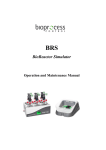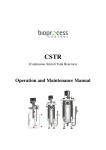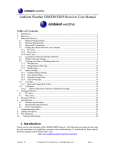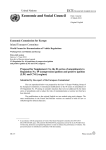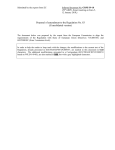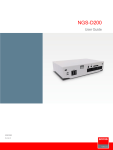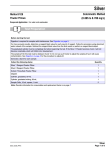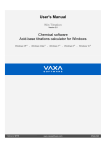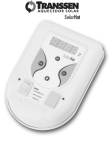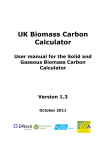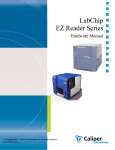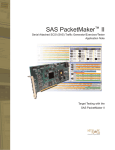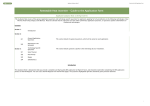Download Biogas Endeavour - User Manual
Transcript
ENDEAVOUR Biogas Endeavour Operation and Maintenance Manual ENDEAVOUR Biogas Endeavour Release History Version 2.0, December 2014 Any questions related to this Operation and Maintenance manual should be directed to: Bioprocess Control Sweden AB Scheelevägen 22 SE-223 63 Lund Sweden Tel: Fax: E-mail: Web: +46 (0)46 163950 +46 (0)46 163959 [email protected] www.bioprocesscontrol.com This document contains proprietary information that is protected by copyright. All rights are reserved. No part of this publication may be reproduced in any form whatsoever or translated into any language without the prior, written permission of Bioprocess Control Sweden AB. Copyright © 2013 Bioprocess Control Sweden AB Produced in Sweden TABLE OF CONTENTS 1 PREFACE ............................................................................................................................... 1 2 GENERAL INFORMATION ................................................................................................ 2 2.1. Conventional Biochemical Methane Potential (BMP) Assay .............................................. 2 2.2. Advantages of ENDEAVOUR over Conventional BMP Test ............................................. 3 3 DELIVERY CHECKS ........................................................................................................... 4 4 PRE-COMMISSIONING ...................................................................................................... 5 5 QUALITY RULES AND RECOMMENDATIONS ............................................................ 6 6 SAFETY CONSIDERATIONS ............................................................................................. 6 7 EQUIPMENT DESCRIPTION (DESIGN/FUNCTION) ................................................... 7 7.1. Sample Incubation Unit ........................................................................................................ 8 7.2. Gas Volume Measuring Device ............................................................................................ 9 7.3 Bioreactor Agitation System................................................................................................ 11 7.4. Technical Characteristics .................................................................................................... 18 8. OPERATION ...................................................................................................................... 19 8.1. Before Start up .................................................................................................................... 19 9. ENDEAVOUR SOFTWARE ............................................................................................. 27 9.1. First Time Connecting and Setting up the Network ........................................................... 27 9.2. Finding the IP of ENDEAVOUR ....................................................................................... 30 9.3. Function and Operation ...................................................................................................... 31 9.4. Troubleshooting .................................................................................................................. 43 10. MAINTENANCE ............................................................................................................. 47 APPENDIX A BMP TEST USING ENDEAVOUR – METHOD DESCRIPTION…………………….48 APPENDIX B BMP AND BIOGAS YIELD CALCULATION FROM DATA GENERATED BY ENDEAVOUR………………………………………………………………………………55 APPENDIX C LICENSES FOR THE OPEN SOURCE SOFTWARE ON ENDEAVOUR……………62 1 PREFACE Bioprocess Control Sweden AB Bioprocess Control Sweden AB (BPC) is a market leader in the area of advanced instrumentation & control technologies for research and commercial applications in the biogas industry. The company was founded in 2006, and today brings to market more than 15 years of industry leading research in the area of instrumentation, control and automation of anaerobic digestion processes. In 2009 BPC launched the Automatic Methane Potential Test System (AMPTS), a revolutionary product in the area of on-site lab equipment for biomethane potential analysis. Today, the second generation of AMPTS is used by biogas researchers, commercial operators and other industry actors in over 30 countries within the Americas, EMEA, Africa and Asia Pacific regions. As of July 2013 the new Biogas Endeavour (ENDEAVOUR) has been offered to the market. The new instrument, ENDEAVOUR, is a well engineered analytical device developed for online measurements of ultra low biogas flows produced from the anaerobic digestion of biological degradable substrates. Taking into consideration the high number of AMPTS units in use today around the world, it is expected that the AMPTS and ENDEAVOUR will become the technology of choice for universities, private labs and biogas operators interested in efficiently determining the true biomethane or biogas potential of different substrates. 1 2 GENERAL INFORMATION The design and construction of full-scale anaerobic digesters based on substrates from single or multiple sources requires a good understanding of the physical and biochemical characteristics of each individual substrate. Biological or biochemical methane potential (BMP) tests, i.e. anaerobic biodegradability assays, are used to determine the anaerobic biodegradability and ultimate biogas or methane potential of wastes, as well as the biodegradation rate under laboratory conditions. 2.1. Conventional Biochemical Methane Potential (BMP) Assay A conventional BMP test provides a preliminary indication of the biodegradability of a substrate and of its potential to produce methane or biogas via anaerobic digestion. Methods based on measuring the gaseous end product have been developed and reported as standard protocols with a variety of experimental setups. The normal procedure to determine methanogenic activity involves inoculating a number of vials containing a small amount of the target media with anaerobic inoculum, incubating them at a controlled temperature, and periodically checking for the methane production by manual sampling and determination of the volume of gas released, and analyzing the gas composition using gas chromatography (GC). Unfortunately, the above described procedures are very time- and labor-consuming due to the large number of vials usually employed and fairly long incubation periods (i.e., over one month). Moreover, the biogas produced and its methane content can only be measured periodically, making it impossible to obtain satisfactory data to fully understand the degradation dynamics. Furthermore, it is difficult to perform the test satisfactorily within the normal working routines of a laboratory. Therefore, there is a need for a highly automated biogas potential test that allows for the collection of high quality data that is less laborintensive. The ENDEAVOUR has been developed by BPC for on-line measurements of ultra low biogas or bio-methane flows produced from the anaerobic digestion of any biological degradable substrate (both solid and liquid form) at laboratory scale. From the biogas producers’ point of view, understanding the potential of a substrate to produce methane and its dynamic degradation profile has a significant impact on the choice of organic waste/material to digest when producing biogas, as well as provides a better understanding of the quality of the raw gas produced from a biogas production facility. The latter has in turn an impact on the total volume of upgraded bio-methane that can be produced from a commercial biogas site. Thus, understanding the methane potential of a substrate can have a direct bearing on the profitability of a commercial biogas producer, as well as the volume of bio-methane produced. 2 2.2. Advantages of ENDEAVOUR over Conventional BMP Test The ENDEAVOUR provides the following advantages: • • • • • • • • • • • • Automated analytical procedure, reducing work load User friendly interface for experiment setup, real-time data display and analysis overview Real-time data logging of accumulated biogas volume and flow rate Real-time pressure and temperature compensation for gas volume and flow measurements Real-time gas flow and volume normalisation Algorithm to avoid an underestimation of gas volume and flow (which may be induced by the solubility of gases in water) Algorithm to avoid an overestimation of gas volume and flow (which may be induced by the flush gas, such as nitrogen gas, during experiment setup) Possibility of multiplexing, allowing for simultaneous batch analysis at different startup times High quality data for extracting process kinetic information Standalone instrument with embedded data acquisition and web server for remote access Low and easy maintenance One of the most cost competitive solutions on the market today 3 3 DELIVERY CHECKS At delivery, unpack and check that the contents match with what is listed below in the Section “Box Content”. If the packaging or the equipment is broken at delivery, please: a) Document and take photos of the parts and packaging b) Inform the transport company at the time of delivery c) Make sure that the transport company documents the incident d) Inform BPC of the incident BOX CONTENT See also Chapter 7. Equipment Description (Design/Function) for pictures of the included parts. UNIT A 6 glass bottles, 2000 ml as reactors 6 plastic caps with agitators/motors, including 5 short motor cables 1 long motor cable (from Motor Controller to first motor unit) 1 signal cable (from Unit B to Motor Controller) 6 rubber stoppers with 2 metal tubing, 1 plastic tubing and rotating shaft for mixing 1 thermostatic water bath (the models can differ, therefore the picture does not necessary conform to the reality) 1 plastic glass lid for the water bath, with 6 circular openings for reactors 6 helical couplings 6 plastic tubing clamps UNIT B 1 measuring unit (including water tank, flow cell holder, 6 injection mould flow cells) 1 plastic glass lid for the water tank 1 manual plastic water pump 1 power adapter (input 100-240 V ∼ 50/60 Hz, output 12 V DC / 5 A) OTHER COMPONENTS 1 shielded Ethernet cord 1 Motor Controller 1 box of 15 m flexible Tygon® tubing 1 number markers kit for tubes 6 plastic lids (blue) 1 Allen key (for helical couplings) 1 manual 4 OPTIONAL EQUIPMENT 6 glass bottles, 1 l (bottles with one port designed for continuous pH monitoring during the batch fermentation) and 6 stirrers adjusted for 1 l bottles 6 glass bottles, 2 l (bottles with one port designed for continuous pH monitoring during the batch fermentation) and 6 stirrers adjusted for 2 l bottles Gas sampling units 6 glass bottles, 500 ml for removing CO2 6 plastic screw caps with hole 6 rubber stoppers with 2 metal tubes 4 PRE-COMMISSIONING The following items are not included in the delivered ENDEAVOUR, however they will/may be required to operate the ENDEAVOUR: • • • • • • • • Thermometer for temperature indication in the thermostatic water bath N2 or a mixture of N2/CO2 to obtain anaerobic conditions during the sample preparation phase (BPC recommends a mixture of N2 (60%) and CO2 (40%) to be used) NaOH (reagent grade 97%, pellets, e.g. Sigma-Aldrich 221465 or equivalent quality) for CO2 fixation, if the bio-methane is measured instead of biogas pH indicator: Thymolphthalein (2’,2”-Dimethyl-5,5”-di-iso-propylphenolphthalein, C28H30O4, CAS 125-20-2, ACS reagent, dye content 95%, e.g. Sigma-Aldrich 114553 or equivalent quality) Ethanol (ACS reagent 99.5%, e.g. Sigma-Aldrich 459844, or equivalent quality) Silicone spray or other similar lubricant Additional wall socket adapters (plugs/contacts) (the ones supplied are according to European, US or UK standards, depending on original purchase order) If the customer has a GC and is interested in off-line biogas composition analysis, gas sampling units can be ordered separately from BPC. Alternatively, reactors can be connected with NaOH bottles to obtain the total methane production. 5 5 QUALITY RULES AND RECOMMENDATIONS • • • • • • • • The product guarantee provided corresponds to the guarantee stipulated on the confirmed product order form and shipping documentation. The removal of the bottom plate on Unit B is considered a breach of guarantee. For guarantee claims relating to the thermostatic water bath, contact the manufacturer directly (see separate handbooks) and inform BPC. BPC recommends using a mixed oxygen free gas (ideally 60% N2 and 40% CO2), to remove any remaining air in the headspace of the bottles to create anaerobic conditions. When 2000 ml bottles are used as reactors, the recommended headspace in the bottles during the methane potential test analysis is approximately 300 - 400 ml. For a high accuracy analysis, the ENDEAVOUR should not be exposed to mechanical vibrations and/or high frequency radio transmissions. Only the parts delivered with the product can be used with the system in order to guarantee the quality and performance of the product. The system contains alkaline AA batteries that need to be handled accordingly. BPC reserves the right to correct any possible text and image errors as well as changes to technical data in this manual. BEFORE GETTING STARTED • • • Read this manual and additional separate manuals for the individual instruments before installing and using the equipment. Keep the instruction manual for future reference and make sure it is easily available for people who regularly use the ENDEAVOUR. Read the Bioreactor Agitation Systems instruction manual before using the equipment. 6 SAFETY CONSIDERATIONS When handling NaOH, always use safety glasses, a lab coat and plastic gloves. Using the ENDEAVOUR and the handling of NaOH should always be done in an environment with good ventilation. See the safety data sheet for your chemicals for further information. See the safety data sheet for your chemicals for further information. Always be cautious when handling electrical devices close to water. The Agitation System contains rotating parts. Make sure to tie back any loose hanging objects like clothing or hair when using the instrument. The power adapter for the multifunction brushless DC Agitation System must never be used in the ENDEAVOUR detection unit. 6 7 EQUIPMENT DESCRIPTION (DESIGN/FUNCTION) The ENDEAVOUR follows the same measuring principles as conventional methane potential tests (see Appendix A), which make the analysis results fully comparable with standard methods. However, with the ENDEAVOUR, the analysis and data recording are fully automatic during the long incubating period, which significantly reduces the time- and labordemand for carrying out the analysis. Moreover, a high quality of data can be obtained, which can be used to extract kinetic information of the degradation process. This will in turn allow for a much better understanding of the dynamic degradation behavior of a specific biomass substrate, further leading to an improved process operation. The instrument setup can be divided into two units: A and B (please refer to the included photos). In unit A (sample incubation unit), up to 6 vials containing small amounts of a sample with anaerobic inoculum are incubated at a desired temperature. The media in each vial is mixed by a slow rotating agitator. Biogas is then continuously produced, a parameter which is used to estimate the biomethanation activity inside each vial. In unit B (gas volume measuring device), the volume of biogas released from each vial is measured using a wet gas flow measuring device with a multi-flow cell arrangement (6 cells). This measuring device works according to the principle of liquid displacement & buoyancy and can monitor ultra low gas flows; a digital pulse is generated when a defined volume of gas flows through the device. An integrated embedded data acquisition system is used to record, display and analyse the results. 7 7.1. Sample Incubation Unit Unit A A1 Multifunction brushless DC motor A2 Rubber stopper with 2 metal tubes, 1 plastic tube and rotating shaft for mixing A3 Glass bottle 2000 ml as reactor A4 Plastic lid to water bath with 6 circular openings for reactors A5 Thermostatic water bath A6 Plastic screw thread cap/motor holder A7 Bent stir rod/rotating shaft A8 Helical coupling 8 7.2. Gas Volume Measuring Device 9 Unit B B1 Injection mould flow cell B2 Water bath package (including water tank, flow cell holder, protection plate and electronics) B3 Manual plastic water pump B4 Connection block B5 Motor signal connection socket for the Motor Controller: 12 V DC / 3 A B6 Power connection socket for the power adapter: 12 V DC / 5 A B7 Shielded Ethernet socket B8 Power adapter 12 V DC/ 5 A 10 7.3 Bioreactor Agitation System Two different bioreactor agitation systems are available from Bioprocess Control: i) an initial configuration (in left picture) based on standard brush DC motors with a gearbox and ii) a multifunction version (in right picture) based on a unique design of brushless DC stepper motors. For a full description of each system, please refer to the Bioreactor Agitation Systems manual. The reasons for introducing a new agitation system are: • • To increase the life span of the system by changing to a brushless stepper DC motor based system for direct drive. To offer improved and more flexible mixing properties by adding new features: o Reversal of motor direction (clockwise [CW]/counter-clockwise [CCW]) o Timer function to set time periods for the motor reversal o Remote speed control on a broad range (i.e. 5-100%) A photo of the multifunction configuration of the motor, the brushless DC stepper motor, is presented below. The complete agitation system consists of the following components: Motor Controller, 24 V power adapter for the Motor Controller, brushless steppers DC motor units with plastic caps, helical couplings, short motor cables (0.2 m), long motor cable (1.5 m), signal cable and a hex tool. 11 MOTOR CONTROLLER The Motor Controller provides power to the motors via the motor cables, and it is very important that the Motor Controller always is turned off and is unplugged from the power source when any cables are connected or disconnected from the motors. Turning the switch off is not enough. The Motor Controller is the hub of the agitation system. It interprets the speed signal sent from the Unit C of the AMPTS II and controls the direction of the motors. All the mixers receive the same information from the Motor Controller. The picture below shows the control panel on the front side of the Motor Controller. 12 The ON/OFF switch (shown in the picture above) turns the power of the Motor Controller on and off. When the switch is ON (in the upper position), the red LED will be lit up to indicate that the system is active. It is recommended to set the switch to OFF before connecting / disconnecting the Motor Controller to / from the power mains. When the AUTO switch on Motor Controller is set to OFF, the mixers will be operated in continuous rotation mode, i.e. the mixers will always rotate in the same direction. Setting the switch to ON will activate the AUTO reversing mode, which will make the Motor Controller change the mixer directions at regular intervals. For the Auto reversing mode to work as intended, the DIRECTION switch on each motor needs to be in the AUTO (middle) position as well. If the switch is in either CW or CCW position, the mixer will start and stop but never change direction. See section Direction Switch for further explanation of the different combinations of settings on the Motor Controller and the motor units. SIGNAL CABLE The Motor Controller receives signals from the test system through an analogue signal cable (pictured below). WARNING: The position of the signal and grounding terminals of the connectors are reversed on the Motor Controller compared to the AMPTS II system. On the Motor Controller, the ground is at the bottom terminal (see the picture below). Always make sure the proper cable is used and that it is inserted the correct way, or the system could be permanently damaged! 13 MOTOR CABLES The signals from the Motor Controller are distributed to each motor unit through the motor cables (see picture below). They should be connected serially, and are fastened to the motor units with the help of latches. The 1.5 m cable is used only to connect the “MOTOR” output on the Motor Controller to the first motor. MIXING INTENSITY The motors can be operated at different speeds ranging from 10-200 RPM. The speed is adjusted linearly between 10 and 200 RPM, referred to as per cent (5 – 100%) in the AMPTS II software. At a DC-signal of 0 (zero) V, the motor is out of function, and at 12 V it is rotating at top speed (200 RPM). An acceleration /deceleration ramp is built into the system to provide a smooth transition between different speeds. TIMER TO CONTROL INTERVALS OF MOTOR REVERSAL The rotary Timer switch can be used to set the time that should elapse before the direction is changed. 10 positions are available ranging between 5 s to 1 h. Timer Switch Position 0 1 2 3 4 5 6 7 8 9 Time 5s 15 s 30 s 45 s 60 s (1 min) 120 s (2 min) 300 s (5 min) 600 s (10 min) 1800 s (30 min) 3600 s (60 min) 14 FUSE To protect the Motor Controller, the Printed Circuit Board (PCB) is fitted with a slow-blow 2 A fuse (522.520). If none of the mixers are working even though the power supply is connected, this fuse should be replaced. The fuse is located inside the Motor Controller, which can be opened by removing the four screws placed in each corner of the top cover. (See picture below). MOTOR UNIT Each motor unit has its own driver board, which controls the power distribution to the actual motor. The switches are explained below. 15 MOTOR UNIT ON/OF SWITCH The ON/OFF switch is located on the side of the motor, and marked on the very top of the motor unit, just above where the actual switch is located. When a mixer is active and power is supplied, an LED next to the ON/OFF switch will be green. If not all mixers will be used, setting the ON/OFF switch to OFF can turn each motor off individually. The motor unit will make a sound to indicate when this is done. It is recommended to set the switch on each Motor Unit to the OFF position before connecting or disconnecting the Motor Controller or any of the motor cables. When the system has been turned off, and then switched back on, it can take up to 8 seconds for it to start up again. DIRECTION SWITCH The DIRECTION switch is located on the side of the motor, and marked on the very top of the motor unit, just above where the actual switch is located. It is used to set the motor to rotate in a CW or a CCW direction. Setting the switch to AUTO gives the Motor Controller automatic control over the reversal of the direction. Below is a table that will show the output of the different combinations of switch settings on the Motor Controller and the motor unit. Settings Motor Controller AUTO switch ON Motor unit switch CW Mixer output Intervals ON AUTO ON CCW OFF CW Starting and stopping according to Motor Controller intervals Starting and stopping according to Motor Controller intervals Starting and stopping according to Motor Controller intervals N/A OFF AUTO N/A OFF CCW N/A 16 Rotation Constantly CW The latest direction used before the Motor Controller AUTO switch was set to off Constantly CCW Reversing directions Constantly CCW Constantly CW RESET BUTTON If an error is encountered somewhere on the driver board in the motor unit, a red LED will light up on the side of the motor unit, opposite to where the switches are located. A marking on the top of the motor unit shows where to find it (see picture below). The problems could be e.g. high temperature, a disconnected motor cable, or power loss. If this happens, the mixer can be reset with a quick press on the RESET button. The RESET button is marked on the very top of the motor unit, just above the actual button. It can be reached by using a pen or other pointy object. If the mixer was reset successfully, the red LED will turn off. POWER The Motor Controller is powered by a 24 V / DC 2.71 A power supply adapter. The power supply is then distributed serially from the Motor Controller, through the 8-pin signal cables, to each motor unit. WARNING: The power supply always has to be disconnected from the Motor Controller before removing or connecting any of the cables from the motors. 17 7.4. Technical Characteristics GENERAL Usage: indoors in an environment free of corrosive agents and with normal humidity levels Power supply: 100 or 240 V ~ 50/60 Hz (thermostatic water bath and power adapter) Tubing material: Tygon® (ID 3.2 mm, OD 4.8 mm) Weight: approx. 25 kg SAMPLE INCUBATION UNIT Maximum number of reactors per system: 6 Reactor material: glass Standard reactor volume: 2000 ml Power consumption: 1300 W (maximum) Dimension: 53×33×24 cm Temperature control: up to 95 °C (precision 0.2 °C) Mixing in the reactor: mechanical (adjustable interval and speed), maximum speed 140 rpm GAS VOLUME MEASURING DEVICE Working principle: liquid displacement & buoyancy Up to 6 cells running in parallel Built-in pressure and temperature sensors Embedded data acquisition (maximum capacity 2×104 flow cell openings)1 Web based software running on embedded server Detection capacity: up to 33 l cumulative gas per channel for each batch test Measuring range for instant gas flow rate: 10 to 120 ml per min Measuring resolution: 10 ml Power consumption: 15 W (average), 28 W (maximum) Dimension: 55×37×31 cm Housing: plastic Accuracy: 5% (RE) & Precision: 1% (CV) 1 See the “Data Reset” section in chapter 9 on how to proceed if this limitation is exceeded. 18 8. OPERATION In this section, references are given to pictures in the Chapter 7. Equipment Description (Design/Function) in the form of a letter and number within parenthesis e.g., (A1). See also the user manual for the thermostatic water bath before installation and use (Instructions manual, Water Bath VWX, Bioprocess Control). 8.1. Before Start up If the user of the ENDEAVOUR is interested in measuring biomethane, then the biogas produced in each reactor will pass through individual bottles containing an alkaline solution. For the preparation of NaOH solution for CO2-fixation, the necessary protection should be used. All work should be carried out inside a fume hood while wearing protective equipment (see Chapter 6. Safety Considerations). a) Prepare a 3 M NaOH solution; take into account that the 500 ml bottles (not delivered with the system) should be filled with at least 400 ml each. Be careful and follow safety precautions as this is a highly alkaline solution. After weighing the necessary amount of NaOH, mix it with approximately ¾ of the required total volume of distilled water (e.g., 120 g NaOH in ¾ of 1 l water). The heat generation following dissolution of NaOH in water is high, so that adding small amounts of supplementary water followed by mixing is recommended. When the NaOH is completely dissolved, add the entire amount of remaining water and mix well. b) Prepare a 0.4% Thymolphthalein pH-indicator solution (80 mg in 18 ml ethanol 99.5% followed by addition of 2 ml water). Thymolphthalein is insoluble in water, but it is freely soluble in ethanol. c) Prepare the NaOH solution containing the pH indicator by mixing 5 ml of the 0.4 % Thymolphthalein solution per 1 l NaOH (3M) solution. If all 6 reactors are used, preparation of as much as 3 l NaOH and 15 ml Thymolphthalein is recommended (the additional solution may be necessary for quickly changing the fixation liquid if the solution becomes impaired (the color change from blue to colorless due to the pHindicator Thymolphthalein). d) Add approximately 400 ml of the mixture containing NaOH solution and Thymolphthalein pH indicator into each glass bottle (500 ml). e) Lubricate rubber stoppers on the side that is in contact with the glass bottle, preferably with silicone spray or silicone stick. f) Place a rubber stopper (with two metal tubes connected) in the opening of each bottle, seal by placing the plastic lid on the top, and screw until the thread on the bottle is no longer visible and the lid is properly sealed. 19 REACTORS a) Perform a simple leakage test for each reactor by creating some overpressure by blocking one of the metal tubing ports and injecting air from the remaining metal tubing port, and then immerse the reactor in water to check if there is any air bubble escaping from the reactor. Make sure that all tubing is properly connected and there is no potential leakage anywhere. b) Add the sample (e.g., 2000 g of substrate and inoculum mixture), the blank (e.g., 2000 g inoculum) and the positive control (e.g., 2000 g of cellulose and inoculum mixture) into the reactors. Use at least duplicates for statistical significance (see Appendix A for more details). c) Lubricate rubber stoppers (A2) on the side that is in contact with the glass bottle, preferably with silicone spray or silicone stick. d) Put the rubber stopper (A2) (with two metal tubes and the bent stir rod (A7) connected) in the opening of each bottle (A3) and press the rubber part in order to close the bottle. Avoid pressing the metallic rod as this will lead to a disconnection of the white plastic cap from the bottom of the stir rod and result in gas and liquid leakage from the reactor. e) Pull out the metallic rod from the bent stirrer into the shaft coupling (A8) and attach it before placing the plastic screw thread cap/motor support (A6). Screw until the thread on the bottle is no longer visible and the lid is properly sealed. f) Connect the bent stir rod (A7) to the motor by carefully tightening the two screws on the helical coupling. g) Cut 6 pieces of Tygon® tubing sufficiently in length to connect one of the small metal tubes on top of the rubber lids (A2) of each reactor to the corresponding tubing connector on the connection block (B4) located on the back of the detection unit. h) Cut 6 pieces of Tygon® tubing at lengths of about 10 cm and connect them to each of the free small metal tubes on top of the rubber lids (A2) of the reactors. Close the Tygon tubing with the help of plastic tubing clamps. 20 MOTOR CONNECTIONS a) Make sure that the power adapter for the Motor Controller is disconnected from the power supply. b) The motor units should all have the ON/OFF switch set to the OFF mode. c) Connect one short motor cable to each motor (excluding the last motor in the chain) and then connect the free end of the cable from motor 1 to the free port on motor 2 and so on until motor 6. d) The Motor Controller should have the System ON/OFF switch in the OFF mode. e) Connect the long motor cable from motor 1 to the Motor Controller. f) Connect the signal cable from the Motor Controller to the motor signal port on Unit B. THERMOSTATIC WATER BATH Do not install or use the equipment before reading the separate instructions for the thermostatic water bath (see above). a) Place the plastic glass lid with 6 circular openings (A4) on top of the water bath, in order to minimise the evaporation of water during the experiment. b) Insert all the reactors into the thermostatic water bath (A5) and fill it up with enough water to completely cover the equivalent height of the content in the reactors (ca 8 l). If normal tap water is used, calcareous deposits may appear in the bath and on the heating element. It is therefore recommended to use deionised or distilled water. c) It is recommended to place a thermometer through one of the holes in the lid, inside the water bath, in order to keep track of the real temperature of the reactors during the incubation period. GAS VOLUME MEASURING DEVICE a) Install Unit B on a flat and stable surface. Use appropriate instrumentation (i.e., bubble level device) to verify the horizontality of the surface and to adjust the level of the system placed on the surface. b) Fill up the water bath (B2) with deionised or distilled water. The water level should be within the limits of the marking on the water bath. c) Make sure to remove the protective film from the transparent lid of the water tank. NETWORK CONNECTION a) Connect one end of the Ethernet cord to the gas volume measuring device, Unit B. b) Connect the other end of the Ethernet cord to a computer or to an internal network. c) Make sure the computer is not connected to a wireless network. If possible, temporarily completely disable the wireless capability. d) Make sure that the network cable is connected to the network prior to connecting the power supply. 21 8.2. Start up FLUSHING THE REACTORS a) Before flushing the system with gas to create anaerobic conditions, disconnect the Tygon® tube from the connection block on Unit B (B4). b) Connect the gas source to the Tygon® tubing with the red tube clamp. c) Open the red tube clamp. d) Flush the system with a low gas flow (i.e., 2.5 to 10 l/min) gently for 60 - 120 seconds. e) Stop the flush gas and close the red tube clamp. f) Disconnect the flush gas source. g) Re-connect the Tygon® tubing to Unit B (B4). Repeat the procedure for all the reactors used in the test. Important! Before flushing the system, please, disconnect the Tygon® tubing from Unit B in order to eliminate the risk of damaging built-in check valves in Unit B with the high pressure gas flow. After flushing the system and before starting the data logging, please manually open all the flow cells in the gas measuring device in order to release any remaining flush gas trapped in the flow cell chambers. THERMOSTATIC WATER BATH a) Start up the thermostatic water bath after connecting the device to a power supply, switching the power to “On” at the back of the device and pushing the ON/OFF button in the controller. b) Set the operating temperature if it is different from the value set before the last switchoff. c) Run your application with the “Start” button. MOTOR AND POWER CABLES a) Check that all motor cables are connected to each other, and that the long motor cable is connected between the first motor and the Motor Controller. b) Check that the analogue signal cable is connected between the Motor Controller and the detection unit (Unit B). c) Connect the 12 V power adapter to the detection unit, Unit B (B6), and to a 100-240 V 50/60 Hz standard power socket. After this, connect the 24 V power adapter to the Motor Controller and to a 100-240 V 50/60 Hz standard power socket. 22 IMPORTANT: The power adapters for the Motor Controller and Unit B of the ENDEAVOUR have different characteristics. Make sure the right ones are used, or the system could be permanently damaged! d) Set the System switch on the Motor Controller to ON. e) Set the ON/OFF switches on each motor unit to ON. SOFTWARE a) Make sure that the shielded Ethernet cord is connected to the gas volume measuring device, Unit B, and a computer or a local internal network. Make sure that the network cable is connected prior to connecting the power supply. b) The ENDEAVOUR software for embedded data acquisition and the built in web server will be loaded and started up automatically after powering up Unit B. c) Follow the instructions in Chapter 9. ENDEAVOUR Software step by step for accessing the software interface through an Internet browser, such as Google Chrome, Firefox or the latest version of Internet Explorer. Using Google Chrome is always recommended. d) When software and experiment configuration have been completed, start the data logging function of the ENDEAVOUR software. In the Control menu, activate all the cells for data registration. Open each cell in the gas volume measuring device manually several times and follow the corresponding result of each opening on the plots in the Graph menu of the software to make sure that both the detection system and data acquisition system function properly. 23 e) Check the files obtained when generating a report in the Download report menu. Download these files and open them using Microsoft Excel 2007 (or a later version). If prompted by the software to install Adobe Flash, please do so. f) Re-start the ENDEAVOUR software by pressing the “End experiment” and “Start experiment” buttons for each individual cell (i.e., pause, stop, play). 8.3. Monitoring REACTORS a) If possible, perform a GC analysis to determine the fraction of methane in the raw biogas samples or simply estimate the methane content based on any literature study or previous experimental result for a similar substrate sample. b) Periodically check that the helical couplings that connect the bent stir rod to the motor are well connected and the mixing works properly. THERMOSTATIC WATER BATH a) Periodically check the water level in the thermostatic water bath. b) Fill up with additional deionised or distilled water when necessary. GAS VOLUME MEASURING DEVICE a) Check that the water level in the water bath for the gas flow and volume measuring device is within the recommended range. b) Fill up with additional deionised or distilled water to the recommended water level when necessary. REMOVING CO2 (IF NECESSARY) a) The pH indicator Thymolphthalein will turn from blue to colourless when the CO2 binding capacity of the NaOH solution decreases below optimal. At this point, replacement of the bottle with NaOH solution is recommended, for avoiding the CO2 gas to pass to the detection unit. At 22 °C, up to 25 l CO2 can theoretically be captured in each bottle with 400 ml solution before it needs to be changed. b) To change a NaOH solution bottle, place the tubing clamps on the tubing on each side of the bottle and then disconnect the bottle by gently pulling the Tygon® tubings. Replace the old NaOH solution with a fresh one and open/take off the clamps. SOFTWARE See the Chapter 9. ENDEAVOUR Software for information regarding software function and operation. 24 8.4. End of Operation a) Note the total running time if this is of interest. In the saved data files, the last data collected will be from the last opening of a cell. b) Generate a report in the Download report menu. Download the report and open it to make sure that the report has been generated properly and that no errors occurred while downloading the file. c) Stop the logging by pressing the pause button and then the stop button. Note: When pressing the stop button, the experiment associated with that particular cell can no longer be continued. d) Turn off the thermostatic water bath. e) Disconnect all tubing connections between the reactors and the gas volume measuring device. f) Empty the water from the water bath by using the manual plastic water pump only. Do not pour out water from water bath in any other way. Directly pouring out the water without using the water pump might allow water to flow into the space between the water tank and the stand, as well as flow into the stand. There is a potential risk of electronic damage even if only very limited amounts of water are accidently in contact with the electronic circuit boards inside the stand. DATA HANDLING When a report is generated, save the report in a desired folder on the local computer used to visualise the software interface. See also Appendix and Chapter 9. ENDEAVOUR Software for details on the data handling. The report files are of XML format (with the ending “.xml”) or CSV format (with the ending “.csv”), can be generated anytime during the experiment, and can be used for further data analysis and curve plotting in Microsoft Excel or other software capable of reading the file formats. The name of the data file is automatically generated, consisting of the actual date and time. For example, a file saved on the 16th of July 2013 at 12:30 will get the name “report_2013-07-16_1230.xml” or “report_2013-07-16_1230.csv”. The user will have the possibility to generate a report with or without compensating the effect of the headspace volume and gas solubility on the accumulated volume of gas. The following data are stored in the files: a) Time (hours, days) since the start of the experiment b) The total gas volume in normalised milliliter (Nml) (total accumulated gas volume during the experiment) c) Average gas flow (Nml/h or Nml/day) d) Experimental parameters such as N2, CO2 and CH4 concentration (%) of flush gas, process temperature (ºC), mixer on/off times (s), mixer speed adjustment (%) e) Amount of substrate and inoculum VS (g), volume of the head space (ml). 25 The generated file contains the volume of gas already normalised (1.0 standard atmospheric pressure, 0oC and zero moisture content). The calculations are carried out to compensate for pressure, temperature and saturated moisture content at the above given conditions (based on the values of pressure and temperature registered by the sensors from Unit B). 26 9. ENDEAVOUR SOFTWARE 9.1. First Time Connecting and Setting up the Network Important! Make sure the computer is not connected to a wireless network. If possible, temporarily completely disable the wireless capability. a) Connect the shielded Ethernet cable to the gas volume measuring device, Unit B. b) Connect the shielded Ethernet cable to a computer. Important! Make sure that the network cable is connected prior to connecting the power. c) Connect the power supply (12 V DC) first to the motor module, and then to a standard 100-240 V ∼ 50/60 Hz power socket. Important! Make sure that the motor module’s DC-plug that supports the Unit B with power is already connected before connecting the power adapter. WINDOWS 7 a) In the Windows Start Menu, select “Control Panel”. b) In the Control Panel, select “Network and Internet”. c) Select “Network and Sharing Center”. d) On the left side of the window, select “Change adapter settings”. 27 e) Right click on the appropriate network adapter and select “Properties”. Usually this is named “Local Area Connection”, possibly followed by a number. It is important that the adapter corresponding to the connected Ethernet cable is selected. f) Select “Internet Protocol Version 4 (TCP/IPv4)” and click on the button marked “Properties”. g) Write down the initial settings (e.g., IP address, subnet mask). h) Select “Use the following IP address” and enter the following values in the fields: 1) IP address: 192.168.10.10 2) Subnet mask: 255.255.255.0 i) Select “OK”. j) Click “Close” in the remaining window. WINDOWS XP a) In the Windows Start Menu, select “Control Panel”. b) Select “Network Connections”. c) Right click on the appropriate network adapter and select “Properties”. Usually this is named “Local Area Connection”, possibly followed by a number. It is important that the adapter corresponding to the connected Ethernet cable is selected. d) Select “Internet Protocol” and click on the button marked “Properties”. e) Write down the initial settings (e.g., IP address, subnet mask). f) Select “Use the following IP address” and enter the following values in the fields: 1) IP address: 192.168.10.10 2) Subnet mask: 255.255.255.0 g) Select “OK”. h) Select “OK” in the remaining window. 28 MAC OS X Select the Apple Menu button and select “System Preferences”. a) Select “Network”. b) Write down the initial settings (e.g., IP address, subnet mask). c) Select “Manually” from the “configure IPv4” dropdown menu and enter the following values in the fields: 3) IP Address: 192.168.10.10 4) Subnet mask: 255.255.255.0 d) Select “Apply”. 7.1.1.1 A LL S YSTEMS To access the instrument, open a web browser (Google Chrome is recommended as it provides the best and most compatible feature set for the ENDEAVOUR). In the address field enter, http://192.168.10.11 The address can be saved in the bookmarks of the web browser. If multiple ENDEAVOUR units are installed, log the IP address for each individual system. Below is a quick guide to make sure that all settings have been made correctly. ENDEAVOUR IP Address Subnet mask 192.168.10.11 255.255.255.0 Computer IP Address Subnet mask 192.168.10.10 255.255.255.0 Please note that the IP address for the computer and the IP address for the ENDEAVOUR are different. This is a design requirement of the IP protocol. Care needs to be taken so that the 29 same address is not used in both locations as it will render the system inaccessible from the designated computer. Connect the system to a network If the system is to be connected to an internal network (and/or the Internet), please follow the steps below: a) Log in to the ENDEAVOUR by entering the user name (user) and the password (bpc). b) In the web browser window, showing the ENDEAVOUR web application, click on the tab marked “System”. c) If using a Dynamic Host Configuration Protocol (DHCP) server located on the internal network to assign an IP address to the system, click on the checkbox marked “Obtain an IP address and DNS information automatically”, select “Apply network settings” and click “Yes” in the confirmation dialogue. If the system is not supposed to use a DHCP server, manually enter the required network information followed by selecting “Apply network settings” and clicking “Yes” in the confirmation dialogue. Important! Changing the network settings might make your system unreachable if you enter incorrect information. Contact the IT department to make sure that the correct settings are applied. If, for any reason, the wrong settings are applied, the ENDEAVOUR can be reset to the factory default settings by pressing the reset button located at the back of the unit. This will reset the unit to its default state with the default network settings. d) Disconnect the provided shielded Ethernet cable from the computer (not the ENDEAVOUR) and connect it to the internal network. e) Change the network settings on the computer to reflect the state they were in prior to starting the ENDEAVOUR configuration and, if needed, reconnect it to the internal network. 9.2. Finding the IP of ENDEAVOUR If you configure the ENDEAVOUR system to use a DHCP server, the unit will request an IP address from a local server on the network. In order to access the system, this IP address needs to be known. Due to the complexities and different setups that can be present in a network, there is no easy way to describe how this IP address can be found. The recommended procedure is to get this information from the local IT department. 30 9.3. Function and Operation LOG IN The page is used to log in to the ENDEAVOUR. a) Press “Log in to the Biogas Endeavour instrument” b) Write in the user name: user c) Write in the password: bpc (default password) 31 HOME The web interface is organized in a number of pages, all reachable from the start page named “Home”, which is the first page the user enters. Documentation and instructions regarding the ENDEAVOUR are available on the page. The pages are organised in the order an experiment is setup, executed, monitored and finally documented. The following pages are available: Home The home page also contains links (to the right) to different kinds of information, such as operation and maintenance manual, technical specification and product information sheets. Experiment The user prepares an experiment by calculating and setting up individual data for each reactor/cell. Control The user can start, pause and end an experiment. The user can also control the speed of the motors driving the reactor stirrers. Graphs Two graphs showing the accumulated gas volume and flow rate vs. time are displayed. Download Report The user can generate a report from the page. The report contains experimental data for each reactor/cell. 32 System This page contains the configuration of IP addresses and cell volume settings, the system log and set date and time. Performing a system reboot is also possible from this page. EXPERIMENT This page is used to setup an experiment and to give guidelines to the user regarding the setup of the experimental reactors. The user starts by selecting which flow cell reactor shall be used for the experiment by selecting one of the radio buttons. Experiment settings The user enters relevant values for the total amount of sample, volatile solids (VS) content of inoculum and substrate, inoculum to substrate VS ratio (e.g. 2; 1.5 or 0 if no substrate is added), total reactor volume (for 2000 mL bottles, this volume was estimated to 2300 mL) and the expected CH4 content of the produced biogas. When the user has filled in the values, 33 the data is saved by pressing the button: “Store settings”. The software then automatically calculates and presents the values for the amount of substrate and inoculum which need to be added in each reactor. The user has the possibility to see simultaneously the calculated values for all reactors by activating the hidden Guideline matrix function (Show !). Common experiment settings Some settings are common for all cells, for example the initial headspace gas composition in the bottles, the process temperature and the headspace and gas solubility compensation, respectively. The “headspace gas compensation” removes the overestimation error when the reactor headspace is flushed by a gas with different composition than biogas. The “gases solubility compensation” removes the underestimation error due to the solubility of gases in the liquid barrier (i.e., distilled water) of Unit B. These calculations are necessary when the total volume of CO2 or biogas is measured, since the solubility of CO2 is much higher than the solubility of CH4 in distilled water (1.45 vs. 0.02 g/l or 0.74 vs. 0.03 l/l). To save the settings, press the button “Store settings”. 34 CONTROL This section handles the Control pages. The page shows different controls that can be changed by the user. Motor Control Through this function the user can control the speed and the mixer on/off time. The motor status is either on or off. To activate the settings, the button “Apply motor settings” has to be pressed. The settings are the same for all motors. Important! The motor speed should only be set at a value higher than 80% to prolong the life time of the motors. 35 Cell control Each flow cell has a set of buttons that control the experiment. The first is the start experiment button. When hovering over it with the mouse the text “Start experiment” is displayed. Important! When pressing the “Start experiment” button a new session is started and all data from the previous session will be deleted. An experiment may be paused at any time. This is done by pressing the corresponding “Pause” button. During pause no data is recorded, but the time is still registered. By pressing the “Pause” button again the experiment will continue normally. When the pause button has been pressed, the “End experiment” button becomes available. By pressing the “End experiment” button neither data nor time are further recorded. The collected data is available until the next time the Start experiment is pressed. 36 GRAPH This section shows what the Graphs page may look like. In some browsers the data might not initially display and reloading the page might be necessary. Cell status All 6 cells have a checkbox. Active cells have a colour assigned to them. If a cell is not active, the assigned colour is grey. When hovering over an active cell, the latest cell opening time is displayed. Accumulated gas volume and flow rate The two graphs show the accumulated gas volume and the current flow rate for the selected cells. The values displayed in the graphs are adjusted for “Gas solubility and/or initial headspace composition” (if selected) and the gas volumes are normalised to 1.0 atmospheric pressure, 0 ºC and zero moisture content. 37 DOWNLOAD REPORT On the Download report page, it is possible to select the unit for the time (e.g., quarter of hour, hour or day), as well as to generate a report. 38 SYSTEM This section shows what the System page looks like. The page contains settings that are configured during the installation of the system and do not need to be modified afterwards. The page also gives the user the possibility to log the status/latest actions of the system. Network The system can be set up to obtain an IP address automatically; if this is not possible (e.g., no DHCP server available), an IP address can be entered manually. The system has a default IP address. If this address is changed, a system reset will change it back to its default value. Flow cell volumes Each cell has a unique volume. When the cells are manufactured, the volumes are calibrated and pre-saved on the system. Time settings The system time can be set either by synchronising towards the connected browser or an NTP server. Using an NTP server requires that the system has a working connection to the Internet. System power This menu performs a system restart. This does not affect the ongoing experiments. They will continue as soon as the system is up and running. Be aware that during the reboot, no values will be registered. 39 System log The system log provides the user with an updated view of what the ENDEAVOUR unit logging software has registered. This includes both general events, such as flow cell openings (together with time, temperature and pressure) and time for motors starting and stopping. It also includes errors experienced by the various subsystems of the ENDEAVOUR, such as unexpected power loss. When contacting BPC with support questions, it is good to have an up to date copy of the system log and to be able to provide this upon request. 40 DATA This section shows what the Data page looks like. After entering the IP address to the page followed by /app.html#data (e.g., http://192.168.10.11/app.html#data), the raw logged cell data in table format is displayed. In the current state, the cell data is just an image of the file that contains the data. The file that is displayed depends on the selected radial button. Only data for one cell at a time can be displayed. This view is meant as an overview of the raw data and should not be interpreted as the final result of the running experiments. To make full use of the ENDEAVOUR capabilities, a full report using the built-in features of the system should be generated. DATA RESET This section shows what the Data Reset page looks like. When the ENDEAVOUR is instructed to collect more data than the system is designed for, it might become unresponsive and difficult to access. In order to restore the system to a clean state, this page can be used. To access it, enter the IP address of the system followed by /datareset.html. For example, with the default settings enter http://192.168.10.11/datareset.html in the browser address bar. 41 WARNING: Please note that this function should only be used as a last resort. It will remove ALL collected data from the system. After using this function, no report will be possible to generate without conducting a new experiment. It is therefore highly recommended not to rely on this usage as a step in a normal workflow. 7.1.1.2 C ONNECTIVITY In order for the system to be able to function during an experiment, there is no requirement that a computer is connected to the system or that the system is connected to a network. The only time there is a demand for a direct connection between the system and a computer through an Ethernet cable is during the initial setup of the system. The only time there is a demand for either a direct connection between the system and a computer or through a network is during the setup of an experiment and during the generation of a report. There is no effect on the data collection capabilities of the system by disconnecting the Ethernet cable or turning off the connected computer. If the ENDEAVOUR system loses power during an experiment, the data previously stored in the system is again made available after the system is powered up. While the system is unpowered, no gas generated by the reactors will be registered but once power is restored, all active experiments will start to register the gas again. As with all computer equipment, care should be taken to ensure that the system functions after an unscheduled reboot. Make sure that the experiment is running correctly and that data is being collected in an appropriate manner. Also make sure that any other connected equipment, such as the thermal water bath, has restarted safely and with the correct settings. SOFTWARE UPGRADE Care should always be taken to keep the built-in software of the ENDEAVOUR up to date. BPC will, from time to time, issue software updates that can be installed on the system through an easy procedure. These updates can contain both new features and bug fixes so it is imperative that, when an update is received, the system is updated at an appropriate time. In order to install an update issued by BPC, append “upgrade” after the # to the standard ENDEAVOUR url visible in the address bar of the web browser. An example for a standard configured unit would be http://192.168.10.11/app.html#upgrade. This will display the software upgrade interface. 42 Click on the “Choose File” button and select the .zip file sent by BPC. Note: Do not unzip this file and never make any changes to the files contained inside of it. Also, make sure that the filename does not include any parenteses. Some operating systems, such as Microsoft Windows, will sometimes append parenteses to filenames when the same file is downloaded more than once. If this is the case, remove the parenteses from the filenames before using it to upgrade the system. When the file has been properly selected, click on the “Upgrade software” button. During the upgrade process, make sure that the system is not restarted or otherwise loses power. This might result in a failed upgrade. If this happens, redo the entire upgrade process from the start. It is recommended to leave the ENDEAVOUR to finish its upgrade for five minutes to ensure that everything has been installed appropriately. When the upgrade is completed, the system will restart, with all previous data and settings intact and ready for use. To verify that the upgrade has taken place, go to the system tab of the system and, in the top left corner, compare the stated software version number to the version number of the file issued by BPC. 9.4. Troubleshooting This section deals with problems that might arise during the operation of the ENDEAVOUR. The instrument is highly advanced and needs to be handled as such. This means that, from time to time, unintended events might occur or difficulties in handling the equipment might be experienced. It is the intention of this chapter to help minimise the probability of such events and provide advice on how to solve some of the most common problems which can come up during system operation. FINDING THE ENDEAVOUR ON THE INTERNAL NETWORK If there is a problem of locating the assigned IP address of the ENDEAVOUR after connecting it to the Internal network using automatic IP settings (NOTE: This does not apply if you have setup the instrument to be used via a direct shielded Ethernet cable connection from a computer to the ENDEAVOUR instrument), there are few ways of manually detecting the unit. Due to the different ways networks can be setup, there is no way to guarantee that these steps will work. They should thus not be seen as replacements for contacting the local IT department (which is the recommended way of obtaining the IP address of the instrument), but assist if, for some reason, this is not feasible. These instructions are meant for the Microsoft Windows operating systems. USING AN EXTERNAL TOOL (IP TOOLS) Start by entering the following address: http://www.softpedia.com/get/NetworkTools/Protocol-Analyzers-Sniffers/IP-Sniffer.shtml into the web browser to download the IP Sniffer tool. 43 After downloading the file, unzip it to a suitable location and enter the directory created. There, a file named iptools.exe should be available. Start the program and in the main window select Tools -> ARP -> ARP Scan / MAC to IP on the top toolbar. A new window will appear. In the subnet field, there will be a pre-defined value. Usually, this will be the appropriate value for the network the ENDEAVOUR is connected to. If the value here should be changed to reflect the internal network address assigned to new systems, do so. The program will now display a list of IPv4 addresses with associated Ethernet MAC hardware addresses. Check if any of these addresses match the “Ethernet MAC hardware address” associated with the ENDEAVOUR instrument (printed on the back of the instrument). If a match is found, enter this address into a web browser to access the ENDEAVOUR unit. USING THE COMMAND PROMPT IN WINDOWS Start the windows command prompt via the Windows start menu. This is usually located in All Programs / Accessories / Command Prompt. At the command prompt, write “arp –a” (without the quotation marks) and press enter. This will generate a list of the IP addresses currently in the arp cache. Check if any of the values located under “Physical Address” match the “Ethernet MAC hardware address” associated with the new ENDEAVOUR Instrument. If a match is found, enter this address into a web browser to access the ENDEAVOUR unit. If none of these addresses match the “Ethernet MAC hardware address” of the unit, the next step is to update the arp cache by issuing a broadcast ping to your local network. First, find out what the IP address of the currently used computer is by writing “ipconfig” (without the quotation marks) in the command prompt and pressing enter. Find the section that starts with “IPv4 Address”. Next to it, a four block number should be visible, similar in style to 192.168.0.1. If there are several IPv4 sections, this means there is more than one network card active in the computer and care needs to be taken to choose the one representing the internal network that the computer and the ENDEAVOUR are connected to. After finding the mentioned IPv4 field, the subnet mask of the network needs to be determined. This should be located below the IPv4 field and be similar in style to 255.255.255.0. To determine the broadcast IP of the internal network, combine the IPv4 address and the subnet mask. Where the subnet mask indicates 255, retain the original field in the IPv4 address and where the subnet mask indicates something else, substitute that field in the IPv4 address for 255. In the previous example, that gives 192.168.0.1 and 255.255.255.0 and thus the broadcast address becomes 192.168.0.255. Next, in the command prompt, write “ping 192.168.0.255” (without the quotation marks and substituting the broadcast address for the one relevant to the network, calculated as described in the previous step). 44 Wait for the program to run its course (this should take less than a few minutes). Write in the command prompt “arp –a” (without the quotation marks) and check the output. Try to match the ENDEAVOUR Ethernet MAC hardware address to one of the fields and check what IP it is associated with. If a match is found, enter this address into a web browser to access the ENDEAVOUR unit. Depending on the internal network setup, the correct Ethernet MAC hardware address will not be reported. Compare the results from the last “arp –a” to the first “arp –a” actions performed and check if any new IP addresses have shown up. If such addresses are identified, manually introduce them one by one into a web browser to verify if any of them can be connected to the ENDEAVOUR unit. UNRESPONSIVE SYSTEM If the ENDEAVOUR is used to collect more data than is advisable, the system might become slow and unresponsive. It might become difficult to generate reports and change settings. It is thus highly recommended not to exceed the recommended gas production as, in some cases, it can render the collected data completely inaccessible. During this time, the page for the system might still appear to load but no changes will take effect. In order to determine if the system is properly loaded or if the system is unresponsive, go to the systems tab and look at the “flow cell volumes” fields. While the system is in a nonresponsive state, these values will be displayed as “10”. Once the system is ready, these values will be updated to the values calibrated into the system by BPC. If Google Chrome is being used, it might, from time to time, show a dialog box asking if it should keep trying or if it should stop the page. This is due to Google Chrome assuming that the delay is due to a faulty executed program. This is not the case. The delay is because of the very large amount of data accumulated. If using other web browsers, a dialog choice might not be presented and the web browser will simply stop executing the program, thus making it impossible to properly access the system. BPC always recommends using Google Chrome with the ENDEAVOUR. After the system has loaded properly, the report should be possible to generate. As soon as this is done, the running experiments containing large sets of data should be cleared and a new experiment should be started. This does not, however, mean that the system cannot be used to analyse large data sets. The procedure to do so is to run the experiment up until the recommended limit of the system, generate a report and save it, clear the cells and continue. This procedure is then repeated until the full experiment has been finished. After this, the individual reports need to be combined and care taken to assure that the data is combined in an appropriate way. If the system becomes completely unresponsive and it is not possible to access the data the regular way, two options remain. If the data can be considered forfeitable, i.e. it is only for a short time period and the loss is not considered to have too large of an effect on the end results, the data can be completely cleared by using the built in function referred to under the 45 head line “Data Reset” in chapter 9. This will make it possible to use the system again without affecting any of the network settings. Please note that the reset function on the back of the unit should NOT be used for this. The reset function on the back of the unit only resets the network settings and leaves the data intact. If the data is considered high value, it is possible for BPC to access the raw data of the system. Raw data is defined as the time when a flow cell opened as well as the associated temperature and pressure. If internet access is given (to BPC) to the system IP (port 80 and port 22), this raw data can be extracted and the system can also be reset. Please note that this should not be viewed as a solution taken lightly. The raw data, while in itself useful, needs to later on be analysed by the customer. The raw data does not take into account such features built into the ENDEAVOUR report generation function such as normalization, calibration of the flow cells, flush gas calculations, gas solubility in water and so forth. 46 10. MAINTENANCE CLEAN THE EQUIPMENT REACTORS Use a bottlebrush and washing-up liquid (detergent) to clean the inside and outside of the reactors. Rinse well with water. Do not autoclave the stirrers because they contain plastic and rubber parts which are characterised by uncertain heat stability and are therefore not suitable for autoclaving. THERMOSTATIC WATER BATH If normal tap water is used, calcareous deposits may appear on the reactors, in the water bath and on the heating element. Periodical cleaning of the inside of the tank and the heating element with a solution of 10 to 20% hydrochloric acid or a solution of water and vinegar (acetic acid) is advised. Rinse with clean water afterwards. For cleaning of the different parts, use the following products: (i) alcohol (for cleaning of stainless steel) or alcohol with cotton duster (for cleaning of plastic). GAS VOLUME MEASURING DEVICE Rinse with water after use. A soft brush can be used very gently if needed. Make sure that all the flow cells are in the correct position. The position can be checked by lifting the flow cell and making sure that the software registers the opening of the flow cell. Distilled water is recommended to be used for system operation. If NaOH solution is used for removing the CO2, the waste must NOT be poured into the sink. It should be saved in dedicated vessels and disposed of as hazardous waste. See the safety data sheet for the chemicals for further information. 47 APPENDIX A BMP TEST USING ENDEAVOUR – METHOD DESCRIPTION This method description is based on the method used in the BPC-laboratory. It can be used as it is, used as base for developing a new method or it can be replaced entirely by a customer’s own method. Determination of Total (TS) and Volatile Solids (VS) Before starting any BMP test, the biomass should be characterized with regards to total (TS) and volatiles solids (VS). The dry matter, i.e. all inorganic and organic compounds is often expressed as TS and can be measured according to a standard protocol. For a given biomass sample, it is necessary to heat the sample up to 105 °C in order to remove all water content. VS is represented by the organic compounds in the sample. After finishing the TS measurement, heating the sample up to 550 °C for 2 hours should be continued for burning up the organic matter. The weight difference between the sample after heating at 105 °C and 550 °C reflects the VS content of the biomass. The next three steps are usually followed to determine the TS and VS in a target sample: 1). Preparation a) Heat a dish to 550 °C for 1 h. b) Place the dish in a desiccator for cooling. 2). TS determination a) Weigh the dish and record this value. b) Add 2-3 ml of a representative sample into the dish. c) Place the dish with the sample in an oven preheated to 105 °C and allow the volatiles to evaporate for 20 h. 3). VS determination a) Take the dish out of the oven and allow it to cool to RT in a desiccator. b) Weigh the dish and record this value. 48 c) Transfer this dish into a furnace pre-heated to 550 °C (ignition). d) After 2 h, take the dish out of the furnace and cool it to RT in a desiccator. e) Weigh the dish and record this value. TS is calculated as the ratio between the amount of dried sample (mDried) and the initial amount of wet sample (mWet). VS content provides an estimation of the organic material in the sample and it is expressed either as the percent of the TS or as the percent of the wet sample, the second case being applied in the BPC protocol, when VS is calculated as the ratio between the difference in the amount of sample after drying and burning (mBurned) and the initial amount of sample. 𝑇𝑆 % = 𝑉𝑆 % = 𝑚!"#$% 𝑚!"# 𝑚!"#$% − 𝑚!"#$%& 𝑚!"# A template for automatic calculation of the two parameters can be provided by BPC. Please contact BPC in order to get more information. Preparation To be able to start an experiment, at least one substrate and an inoculum are needed. The inoculum is typically the sludge from a full scale biogas plant. It is recommended to use an inoculum which is adapted to the current substrate. If the substrate to test is already used in an existing plant, the inoculum from that plant might be suitable. Be aware that the time between sampling the inoculum and experiment start up should be as short as possible; moreover, the substrate should be as fresh as possible. If this is not achievable, they should be stored refrigerated or frozen. Take into consideration the time necessary to measure TS and VS before starting the experiment. PREPARATION OF THE INOCULUM (OPTIONAL) In order to minimise the amount of biogas that is produced by the inoculum itself, preincubate the inoculum in anaerobic conditions (apply e.g. N2) in order to deplete the residual biodegradable organic material present. This is typically carried out by storing the sludge for 2 to 5 days at a temperature corresponding to the process temperature from where the sludge was taken from and releasing the gas that is produced. When no significant gas production is 49 observed, the sludge is ready to be used. After the pre-incubation step, check the pH and measure the TS and VS of the inoculum. If this step is not performed, subtracting the amount of biogas produced by the inoculum itself from the one produced by the mixture between inoculum and substrate is necessary for calculating the methane potential of that certain substrate. PREPARATION OF THE SUBSTRATE Check the pH of the substrate to make sure that it is not acid, which may cause an inhibition of the biodegradation process. Measure TS and VS. Keep the substrate refrigerated or frozen until the experiment starts. It is recommended to have as short time as possible between sampling of the substrate and start of the experiment. PREPARATION OF NAOH-BOTTLES FOR CO2 FIXATION (IF NECESSARY) a) Prepare a 3 M NaOH-solution by mixing 360 g pure NaOH with distilled water up to 3 l. b) Prepare a 0.4% Thymolphthalein pH-indicator solution (80 mg in 18 ml ethanol 99.5% and 2 ml water). c) Add 15 ml pH-indicator solution to the prepared 3 l NaOH solution. d) Prepare bottles (500 ml) containing about 400 ml NaOH solution (3M) and Thymolphthalein pH-indicator. e) Place the rubber lid (with two metal tubes) into the bottle and screw the cap. If needed, lubricate rubber stoppers on the side that is in contact with the glass bottle when in operation, preferably with silicone spray or silicone stick. PREPARATION OF THE THERMOSTATIC WATER BATH a) Fill up the thermostatic water bath with enough water to cover the reactors (ca 8 l). It is recommended to use distilled water. b) Make sure that the correct temperature is set. PREPARATION OF THE GAS VOLUME MEASURING DEVICE a) Fill up the water bath with enough distilled water to cover the cells in open position. The water level should be according to the water level marking on the water bath. b) To avoid trouble when starting the experiment, it is recommended to start the program and try to open each cell several times to make sure that the detection step is functioning properly. PREPARATION OF REACTORS a) It is recommended to use duplicates (or triplicates if possible) of each combination inoculum-substrate. For one sample, use: o 2 reactors as blanks (containing only inoculum and (optional) water for having the same total volume in all reactors) – used to compensate for the amount of biogas produced by the inoculum itself; o 2 reactors with inoculum + substrate (samples) 50 o 2 reactors as positive controls (containing cellulose or other standard substrate) – to test the quality of the inoculum. b) When preparing the experiment, a certain inoculum to substrate ratio (ISR) needs to be chosen. The appropriate ratio depends on the method chosen or the properties of the substrate. At the BPC laboratory, inoculum to substrate ratios of 3:2 - 2:1 (based on VS) are normally used. However, if it is known that the substrate contains inhibitory substances it is recommended to test higher ratios (i.e., less substrate). c) When this ratio has been decided, the amounts of inoculum (𝑚!" ) and substrate (𝑚!" ) in the sample need to be calculated. A total amount of maximum 2000 g liquid per reactor (for 2000 ml bottle) is normally used in the BPC-laboratory to avoid problems if foaming occurs. If several substrates are to be tested with the same inoculum, calculate the amount of inoculum in accordance with the substrate with the lowest VS value (see formulas below). This amount of inoculum is then subsequently used for the other substrates, and the amount of substrate is then adjusted so that the desired VS ratio is achieved. In this way, only one set of blanks (corresponding to the amount of inoculum added in each reactor) can be used. However, some of the reactors will then contain a total volume smaller than 2000 g. If the same amount is desired in all bottles, these reactors may be filled up to 2000 g using water. 𝑚!" ×𝑉𝑆! 𝑎𝑚𝑜𝑢𝑛𝑡 𝑜𝑓 𝑖𝑛𝑜𝑐𝑢𝑙𝑢𝑚 𝑉𝑆 = = 𝐼𝑆𝑅 𝑚!" ×𝑉𝑆! 𝑎𝑚𝑜𝑢𝑛𝑡 𝑜𝑓 𝑠𝑢𝑏𝑠𝑡𝑟𝑎𝑡𝑒 𝑉𝑆 𝑎𝑛𝑑 𝑚!" + 𝑚!" = 𝑚!"! PREPARATION OF THE REACTORS (EXAMPLE) If a ratio of 2:1 and a total amount of 2000 g are chosen: 𝑚!" ×𝑉𝑆! =2 𝑚!" ×𝑉𝑆! 𝑚!" + 𝑚!" = 2000 The amount of inoculum needed can be calculated according to the following equation: 𝑚!" = 𝐼𝑆𝑅 𝑚!" ×𝑉𝑆! (𝑚!"! − 𝑚!" )×𝑉𝑆! = 𝐼𝑆𝑅 𝑉𝑆! 𝑉𝑆! 51 𝑚!" = 𝐼𝑆𝑅 𝑚!"! ×𝑉𝑆! 4000 ∙ 𝑉𝑆! = 𝑉𝑆! + 𝑉𝑆! ×𝐼𝑆𝑅 𝑉𝑆! + 2 ∙ 𝑉𝑆! The amount of substrate will then be: 𝑚!" = 𝑚!"! − 𝑚!" = 2000 − 𝑚!" If another substrate will be used with the same inoculum, the amount of new substrate is calculated according to the equation below: 𝑚!" = 𝑚!" ×𝑉𝑆! 𝑚!" ×𝑉𝑆! = 𝐼𝑆𝑅×𝑉𝑆! 2 ∙ 𝑉𝑆! Important! All calculations to determine the necessary amounts of substrate and inoculum for a certain VS ratio are automatically carried out by the ENDEAVOUR Software (see Section “Experiment” in the Chapter 9). Start Up Procedure Two different methods may be applied depending on the presentation of the substrate. START UP ALTERNATIVE 1 All bottles are filled with the same amount of inoculum (prepare one extra mix of each sample for measuring pH, TS and VS). Leave 2 bottles as blanks (add water up to 2000 g if desired). For each substrate, add the calculated amount (depending on the inoculum to substrate ratio desired) to each one of the two replicate reactors. If only one substrate is going to be analysed, add cellulose (as a control) to two of the reactors (fill up to 2000 g with water if desired). This method is especially suitable for solid substrates. START UP ALTERNATIVE 2 Mix the inoculum and substrate for the two reactors with the same substrate/cellulose in one batch and then distribute 2000 g of this mix into each bottle. GENERAL START UP PROCEDURE a) Mark all reactors and their lids. b) Fill up the reactors with inoculum and substrate. c) If needed, lubricate rubber stoppers on the side that is in contact with the glass bottle when in operation, preferably with silicone spray or silicone stick, and tighten the plastic screw cap carefully. d) Fasten the stirring stick to the motor. e) If not already done, mount a short piece of Tygon® tubing on one of the metal tubes of the lid and place a tube stopper on it. 52 f) Place all reactors in the water bath (optionally measure pH) and connect to the CO2fixing bottles (if the accumulated volume of methane has to be measured instead of biogas) and to the flow cells. Fill up with more water if necessary. g) Connect the contacts for the stirring to the individual motors and, lastly, to the gas volume measuring device. Connect the Ethernet cable to the internal network (or computer if the system is not used within a network) and to the gas volume measuring device. Lastly, connect the power supply (input 100-240 V ~ 50/60 Hz, output 12 V DC/3 A) to the wall outlet and to the gas volume measuring device. h) Flush all reactors with N2 for approximately 1 minute, using the extra inlet in the lid, to achieve anaerobic conditions. i) Empty each flow cell. j) Start the data logging program, see instructions in the ENDEAVOUR Software Chapter. During the Experiment a) Check the water level in the thermostatic water bath and the water bath periodically and fill up with distilled water when necessary. b) If the system has been equipped with the extra gas sampling valves (can be ordered at BPC), GC analysis can be performed to measure the gas composition any time during the experiment. End of Experiment The test period often spans between 30-60 days. End the test when the daily biogas production is equivalent to only 1% of the total volume of gas produced up to that time (VDI 4630). a) Turn off the thermostatic water bath and disconnect the contacts for the stirring. b) Disconnect the reactors one by one from the CO2-fixing bottles and measure the pH in each reactor. c) Measure TS and VS in each reactor in order to check for VS reduction (if necessary). d) Disconnect the CO2-fixing bottles. e) Wash reactors and other equipment. f) Empty the thermostatic water bath after it has cooled down to ambient temperature. g) Process the data. 53 Data Processing a) If the biochemical methane potential (BMP) of a substrate is evaluated, the most interesting parameter to evaluate is the amount of gas produced per gram of VS added. Use a mean value of the two blanks when withdrawing the gas production from the inoculum. 𝐵𝑀𝑃 = 𝑉! − 𝑉! 𝑚!" 𝑚!" 𝑚!",!" • BMP - is the normalised volume of methane produced per gram VS of substrate added (Nl/gVS) • 𝑉! - is the accumulated volume of methane produced from the reactor with sample (i.e., inoculum and substrate) • 𝑉! - is the mean value of the accumulated volume of methane produced by the blanks (i.e., inoculum) • 𝑚!" - is the total amount of inoculum in the sample • 𝑚!" - is the total amount of inoculum in the blank • 𝑚!",!" - is the amount of organic material (i.e., volatile solids) of substrate contained in the sample bottle. If the ENDEAVOUR is measuring the accumulated volume of biogas without removing CO2, the biogas yield is expressed in a similar way as BMP (i.e., quantity of biogas measured under standard conditions generated with each g VS substrate). The degradation profile vs. time can also be plotted. If only one substrate is used, the accumulated volume can be plotted directly. If several substrates with different inoculum to substrate ratios should be compared, calculate the methane potential for each particular case and compare the volume produced per gram of VS. 54 APPENDIX B BMP AND BIOGAS YIELD CALCULATION FROM DATA GENERATED BY ENDEAVOUR In this section some issues important for the definition of the biochemical methane potential (BMP) of organic substrates determined in batch assays and an example for the calculation of BMP or biogas yield of a target substrate using the data generated from ENDEAVOUR are presented. Biochemical Methane Potential (BMP) BMP test is a simple batch assay developed to determine the methane or gas production of a given organic substrate during its anaerobic decomposition. The conventional assay involves incubating a substrate inoculated with anaerobic bacteria for a period of 30 to 60 days commonly at 37°C and monitoring the production of biogas together with its composition throughout the test. The presented gas volume or gas flow rate should be normalised based on dry gas (water content is removed) at 1 atm and 0°C. The experiment is normally carried out with tests in duplicates for statistical significance: 2 reactors as blanks (reactors containing only inoculum), 2 reactors as reference control (e.g., cellulose) and the rest of reactors contain sample(s) (i.e., inoculum and substrate). Information necessary for the BMP determination To be able to determine the BMP the following information is necessary: Parameter Unit Symbol Accumulated gas volume from sample bottle(s) Nml VS Accumulated gas volume from blank bottle(s) Nml VB VS amount of substrate in sample bottle(s)* g 𝑚!",!" VS amount of inoculum in sample bottle(s)* g 𝑚!",!" VS amount of inoculum in blank bottle(s)* g 𝑚!",!" *For wastewater samples, COD (chemical oxygen demand) is often used instead of VS, where VS stands for the volatile solids. All this information is available in the report generated by the ENDEAVOUR equipment. Of course this requires that the user has entered the correct values for total sample amounts and concentrations of substrate and inoculum in the “Experiment” window and also added the amounts of substrate and inoculum calculated by the software in the experimental bottles. In order to determine the true (ultimate) BMP or biogas yield of an organic material, it is important to continuously monitor the gas (either biomethane or biogas) production through 55 the anaerobic degradation of substrate until the gas production is nearly ceased. Preferably, this is confirmed by generating a report and controlling the two flow rates. Formula for calculation of BMP BMP is defined as the volume of methane produced per amount of organic substrate material added to the reactor. Consequently, the accumulated volume from an experiment has to be divided by the amount of organic substrate material added into the reactor. However, in the experimental sample bottle, there will also be organic residues present in the added inoculum which will produce certain an amount of biogas in the anaerobic process and its volume fraction of biomethane has to be subtracted from the total accumulated biomethane volume in order to get the true production from the substrate. Thus, BMP can be expressed according to equation (1). 𝐵𝑀𝑃 = 𝑉! − 𝑉! 𝑚!",!" (1) In equation (1), 𝑉! is the accumulated volume of biomethane from the reactor containing the sample (i.e., substrate and inoculum), 𝑉! is the volume of biomethane coming from the inoculum present in the sample bottle and 𝑚!",!" is the amount of organic material of substrate contained in the sample bottle. In case of wastewater samples, chemical oxygen demand (COD) is often used instead of VS. The blank samples will generate only the amount of biomethane originating from the inoculum (VB), and can further on be normalized to the biomethane production per unit weight of dry organic material in the inoculum. The obtained fraction (VB/mVS,IB) has to be multiplied with the amount of dry organic material (i.e., gram VS or COD) from the inoculum in each sample bottle (mVS,IS) in order to calculate how much biomethane is coming from the inoculum in the sample reactor, as following: 𝑉! − 𝑉! 𝐵𝑀𝑃 = = 𝑚!",!" 𝑚 𝑉! − 𝑉! 𝑚 !",!! !",!" 𝑚!",!" = 𝑉! − 𝑉! 𝑚!" 𝑚!" 𝑚!",!" (2) As seen from the equation (2), the ratio between the amount of organic material from the inoculum in the sample vs. the one in the blank is equal to the ratio between the total amount of the inoculum in the sample (𝑚!" ) and the one in the blank 𝑚!" . Example of a BMP calculation In this example, the BMP will be determined for one substrate and a control. Data is collected from an ENDEAVOUR system that has been running for 30 days. The sample, control and blank have been tested in duplicates (2 identical setups for each). In Figure 1, a screenshot of a generated report from this test can be seen. In the screenshot, the information necessary for determining the BMP of a sample is clearly marked out. Two 56 values are given for each parameter since duplicates are used. BMP can then be calculated according to equation (2). For the substrate this becomes: 20.32 6583 − 3166 ∗ 23 𝐵𝑀𝑃 = = 354 NmL/gVS 10.46 For this particular example, BMP can be calculated in Excel with equation 4: (3) BMP =(AVERAGE(D51:E51)-AVERAGE(B51:C51)*AVERAGE(D15:E15)/ (4) AVERAGE(B15:C15))/AVERAGE(D14:E14) In equation (4), the function “AVERAGE” is used to calculate the mean value of the replicates. The replicates are either in columns D:E (cells 3:4) for the substrate or in columns B:C (cells 1:2) for the blank. Gas production (VB, VS) The accumulated gas volumes are specified in row number 51. However, this number is variable and depends on how long the experiment has been run and which time basis is used. As a general rule, the row number of the last obtained values in the accumulated volume columns should be used. The column letters will be variable, depending on which cells are used and the number of replicates. In this example, columns D:E are used for the substrate since it is added into the reactors connected to flow cells 3 and 4 (Figure 1) and columns B:C since the blank reactors are connected to the flow cells 1 and 2. Organic material (mVS) Row number 14 is always used to obtain the amount of organic material in the substrate and row number 15 is always used to obtain the amount of organic material in the inoculum in an ENDEAVOUR generated report. Calculation of BMP for control The BMP of the control substrate can be calculated in a similar way. The only necessary thing is to replace the column letters for the substrate data. For example, D:E should be replaced with F:G since this control is evaluated in flow cells 5:6 (Figure 1). 57































































